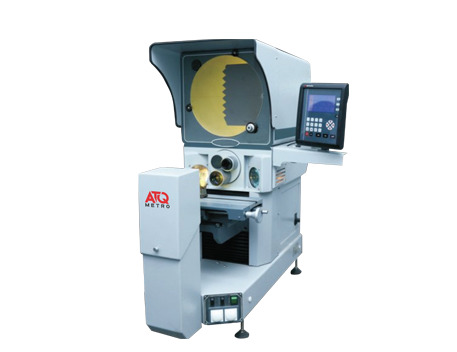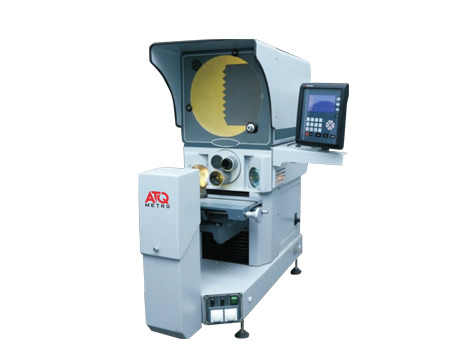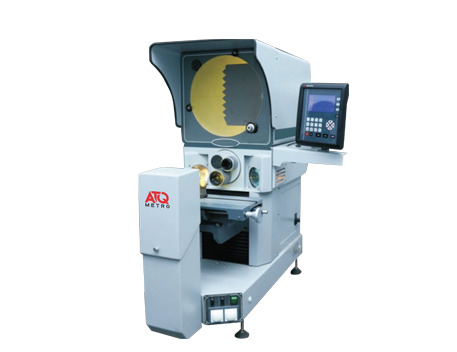#ProfileProjectors
Explore tagged Tumblr posts
Text

Mitoya's Optical Profile Projectors are used for measuring and inspecting the dimensions and contours of objects. They typically use optics and light sources to project a magnified image of the object onto a screen, allowing users to measure various features with precision. These instruments are commonly used in manufacturing and quality control processes to ensure that products meet specified standards. It is the best Optical profile projecture device for measurements on digital display and data processor.
#milling#MitoyaInstruments#ProfileProjectors#Metrology#QualityControl#OpticalInstruments#ManufacturingTechnology#manufactureindustry#Engineering#IndustrialMetrology#QualityAssurance#ProductInspection#OpticalMeasurement#TechInnovation#EngineeringSolutions#ManufacturingQuality#MeasurementTools#engineeringtool#inspectiondevice#mechanicalengineering#engg#machines#mechanical#production#cnc machine#projector
0 notes
Text
Vertical Profile Projector-150

Vertical Profile Projector -150 are widely used in manufacturing, quality control, and metrology applications. They are particularly suitable for inspecting parts with vertical or axial features, such as gears, shafts, threaded components, and cylindrical parts. These projectors provide a non-contact and efficient method for measuring dimensions and profiles with high precision and repeatability. The optical system of a vertical axis profile projector includes a light source, lenses, mirrors, and a projection screen. The light source illuminates the part, and the lenses and mirrors project a magnified image of the part onto the screen.
The workpiece is placed on a stage that moves vertically, allowing for easy positioning and measurement of the part. The stage may have fixtures or clamps to securely hold the part during inspection. Vertical Profile Projector-150 offer different levels of magnification, typically ranging from 5x to 100x or more. They may have interchangeable lenses or a zoom lens system to adjust the magnification level based on the size and details of the part.
Vertical axis profile projectors include measuring scales or digital encoders that allow for direct measurements of distances, angles, radii, and other dimensional features on the part. Digital readouts or computer interfaces can display measurement results and perform data analysis.
#manufacture#industrial equipment#manufacturer#metallurgical#metallographicequipments#profile projector#vertical profileprojector#optical profile projector#optical measuring machine#optical measuring instrument#vertical screen projector#vertical axis profile projector#vertical profile projector supplier#vertical profile projector manufacture#best price of vertical profile projector#vertical profile projector best price#vertical profile projector specification
1 note
·
View note
Text

PROFILE PROJECTOR - ATQMETRO: Overcoming Challenges in Accurate Measurements The PROFILE PROJECTOR - ATQMETRO is designed to tackle common challenges in achieving accurate measurements. Traditional methods often suffer from human error and time inefficiencies. With its advanced optical technology, the ATQMETRO projector provides high-resolution imaging and precise magnification, ensuring reliable results. Its user-friendly interface simplifies operation, reducing the learning curve for new users. Additionally, the projector's robust calibration features help maintain measurement accuracy, making it an essential tool for quality control in manufacturing. #ProfileProjector #ATQMETRO #DimensionalMeasurement #QualityControl #Manufacturing For more information, visit: https://atqmetro.com/profile-projector-2/
0 notes
Text
Measuring & Metallurgical Instruments
Introduction – Measuring and Metallurgical instruments are the instruments/equipments that are used to measure the different physical quantities like Surface quantities, Hardness, Tensile strength, Roughness & Thickness of the real world metallic & non-metallic objects or bodies. In industrial engineering, production and quality assurance, measuring instruments are used to obtain the physical quantities of specimen objects or products for their true value & quality control. The measuring instruments are not limited to the above mentioned objectives but also there are lots of things that you can measure with different measuring devices / instruments.
Calibration of measuring instruments – Calibration is done to compare the measured values by measuring devices/instruments to the calibrated international standards. These comparisons of the measured values are done to find the stability, reproducibility, precision & accuracy of the measuring instruments. Following would be the outcomes of the calibration of a measuring instrument-
a. No error in the device- The device given the exact value in an experiment as that of the standard value.
b. Significant error but no adjustment done
c. An adjustment made to correct the error to reach an acceptable level
Types of measuring and Metallurgical instruments
1. Category wise-
i. Optical measuring instruments
ii. Hardness Testing Equipments
iii. Industrial Microscopes
iv. Environmental Test Equipments
v. Material Testing Machines
vi. Surface roughness testers
vii. Thickness Measuring Gauges
viii. Non-destructive Inspection Instruments ( NDT)
2. Functions-wise-
i. Measuring microscopes
ii. Profile Projectors
iii. Video measuring machines
iv. Rockwell Hardness testers
v. Vickers Hardness Testers
vi. Micro hardness testers
vii. Brinell Hardness Testers
viii. Universal hardness Testers
ix. Metallurgical Microscopes
x. Stereo microscopes
xi. Universal Testing machines
xii. Portable Hardness Testers
xiii. Coating thickness measuring gauges
xiv. Ultrasonic Thickness gauges
Measuring & Metallurgical instruments in different industries & society- Different measuring instruments are used by different industries, Institutions and organizations as per their need. By the way almost all the dimensional measuring instruments are used by the mechanical or physical industries.
Automotive industry
In the automotive industry measuring instruments are required for conducting inspection, measurement, and quality checks for various components and parts. The automotive industry has been increasingly using optical measurement systems and coordinates measuring machines instead of the conventional strain gauges, accelerometers, transducers, and extensometers for improving the safety and comfort level of vehicles. Dimensional metrology or measurement equipments are crucial for automotive industry as designing and styling play an important role in the automotive industry.
Aerospace and Defense
Metrology/Measuring instruments play crucial role also in Aerospace and Defense industry as it is one of the highly competitive industries/market where products performance and their quality is very important for market success. Environmental concerns and Regularity changes are the serious challenges for this industry. As this industry have to use new construction materials, production techniques such as additive manufacturing & advanced machining.
Manufacturing/Production
Nowadays, manufacturing industries are having huge demands of manufacturing more products in a shorter time along with enhanced quality demands and standards. In this situation, unstable & disturbing processes and low precision quality control can cause serious quality problems or production failures. Therefore manufacturing companies are facing huge pressure to remain competitive in their respective markets as they have to optimize and control all of their processes very effectively & economically. Again affordable high precision metrology/measuring equipments are required to meet these challenges.
Benefits of using high precision measuring instruments – As you know quality control have become one of the most important roles for the production in all industries, the industries should move towards the use of high precision metrology equipments with latest technologies for better control on quality, time consumption and economical performance. Measuring instruments are available in the market with –
A. Higher stability
b. High accuracy
c. Digital & Automatic functions that make them easy to use and save time of the industry.
The product development and process validation are directly depending on the high precision measuring instruments while performance of a company & its existence or stability in the market is indirectly dependent.
Quality control is the key to better performance
#measuringinstruments#metallurgicalinstruments#profileprojectors#Industrialmicroscopes#visionmeasuringmachines#vision#measuring#machines#metallurgy#insruments#hardnesstesters#coatingthicknessgauge#materialtestingmachine
0 notes
Text
Horizontal Profile Projector With Data Processor
Horizontal profile projector with data processor is a precision measuring instrument used for the non-contact measurement of 2D profiles of objects. It is specifically designed for measuring the height and width of flat objects such as printed circuit boards, machined components, and stamped metal parts. The projector consists of a high-resolution camera mounted above a horizontal projector screen. The object being measured is placed on a precision stage that allows for accurate positioning and movement of the object. The camera captures an image of the object and projects it onto the screen, magnifying it for easier inspection. The data processor is a computer system that is connected to the projector and used to analyze and measure the dimensions and features of the object being measured. The processor uses sophisticated software to measure dimensions such as angles, radii, and distances. It can also perform statistical analysis and generate reports.
#manufacture#industrial equipment#manufacturer#metallurgical#testing#metallographicequipments#profileprojector#profile projectors#horizontal profile projector#horizontal profile projector supplier#horizontal profile projector manufacture#horizontal profile projector supplier in india#horizontal profile projector manufacture in india#horizontal profile projector supplier in delhi#horizontal profile projector manufacture in delhi#horizontal profile projector supplier in uttar pradesh#horizontal profile projector manufacture in uttar pradesh
1 note
·
View note
Text

PROFILE PROJECTOR - ATQMETRO: How It Supports Reverse Engineering Processes The PROFILE PROJECTOR - ATQMETRO is essential for reverse engineering processes, enabling precise measurement and analysis of existing components. By projecting a magnified image of parts onto a screen, engineers can accurately assess dimensions without disassembly. This capability is crucial for reproducing or improving designs, ensuring that new products meet stringent specifications. The user-friendly interface allows for quick adjustments and measurements, streamlining the reverse engineering workflow. With ATQMETRO, companies can enhance innovation while maintaining quality standards in their manufacturing processes. #ProfileProjector #ReverseEngineering #PrecisionMeasurement #ATQMETRO #QualityControl For more information, visit: https://atqmetro.com/profile-projector-2/
0 notes
Text

PROFILE PROJECTOR - ATQMETRO: Addressing Common Measurement Challenges The PROFILE PROJECTOR - ATQMETRO is essential for addressing common measurement challenges in precision manufacturing. This advanced tool enhances accuracy by projecting a magnified silhouette of the part onto a screen, allowing for detailed inspection. It effectively identifies discrepancies in dimensions and geometry, crucial for quality control. With features like automatic calibration and user-friendly interfaces, operators can minimize human error and streamline workflows. As industries demand higher precision, the PROFILE PROJECTOR stands out as a reliable solution for meeting stringent measurement requirements. #ProfileProjector #ATQMETRO #PrecisionMeasurement #QualityControl #Manufacturing For more information, visit: https://atqmetro.com/profile-projector-2/
0 notes
Text
Vertical Profile Projector
A vertical profile projector is an optical measuring instrument that is used to inspect the profile and shape of small-to-medium-sized flat objects. It is commonly used in industries such as manufacturing, engineering, and quality control to measure and verify the dimensions of a wide range of parts, such as machined components, stamped parts, and injection-molded plastics.
The profile projector consists of a light source, a lens system, a stage or table for holding the part to be measured, and a screen for displaying the part image. The part is placed on the stage and illuminated from below by a light source, which passes through the lens system to project a magnified image of the part onto a screen above. The screen is marked with a reticle or graticule, which is used as a reference to measure the dimensions of the part.
The operator can use a variety of measurement tools, such as micrometers or digital scales, to measure the dimensions of the projected image. Some modern profile projectors are equipped with digital readouts or computer interfaces, which can provide automated measurements and data collection.
#medical equipment#medicalequipment#manufacturer#industrial equipment#manufacture#profile#profileprojector#testing#tools#measurement#optical#profile projectors
1 note
·
View note